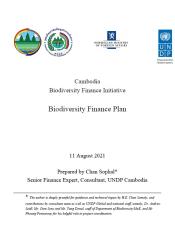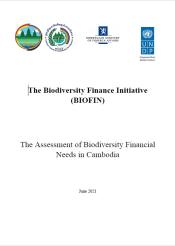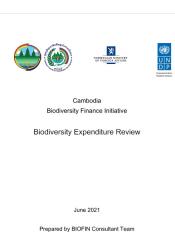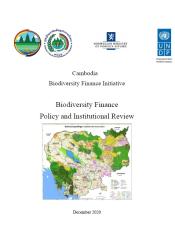Cambodia
Cambodia, located within the tropical belt, is a rich hub of biodiversity, home to a wide array of plant and animal species. A recent inventory highlights the country’s impressive natural wealth, including:
- 163 mammal species,
- 647 bird species, with 7 listed on the global Evolutionarily Distinct and Globally Endangered (EDGE) list,
- 1,357 fish species across freshwater and marine ecosystems,
- 183 reptile species,
- 74 amphibian species,
- 671 invertebrate species, and
- 3,113 plant species
Cambodia’s forests shelter many endemic species and ecosystems, including several that are endangered. Notably, the country accounts for 1.6% of all globally endangered species listed on the IUCN Red List. Biodiversity in Cambodia is not only vital for food security and livelihoods but also holds deep social and cultural significance, woven into the traditions and daily lives of its people.
BIOFIN Cambodia launched its first phase (2019–2021) as the 31st member country, with funding from the Government of Norway. The second phase (2024–2026) is supported by both the German and Norwegian governments. The initiative is implemented by UNDP Cambodia in close collaboration with the Department of Biodiversity, the Secretariat General of the National Council for Sustainable Development, and the Ministry of Environment.
Cambodia successfully completed the BIOFIN methodology during phase I. Cambodia completed key assessments listed in the BIOFIN methodology. Those include 1) Policy and Intuitional Review, 2) Biodiversity Expenditure Review (BER), 3) the Finance Need Assessment (FNA), 4) the Biodiversity Finance Plan (BFP), and Finance Proposals for the prioritized finance solutions. Under BFP, there are nine finance solutions that generate revenues, three are solutions that avoid future biodiversity expenditures and two are solutions that avoid future biodiversity expenditures.
Now in phase II, Cambodia has transitioned into an implementing country. The top three prioritized Biodiversity Finance Solutions (BFS) identified in the BFP have been reviewed, updated, and are currently being implemented. The description of these BFSs is presented in section Finance Solutions below.
1. Developing Sustainable Ecotourism
Empowering local communities to actively and meaningfully engage in biodiversity conservation has become a growing priority in Cambodia, particularly through Community-Based Ecotourism (CBET) initiatives located within or around protected areas (PAs). The primary goal of CBET is to involve communities living in and near these areas in promoting and delivering ecotourism services to both domestic and international visitors. This model enables communities to diversify their income-generating activities while contributing to the sustainable conservation of biodiversity and ecosystems.
CBET has demonstrated multiple co-benefits, including improved livelihoods and enhanced environmental stewardship. Given that most ecotourism sites are situated within PAs managed by the Ministry of Environment (MoE), it is recommended that the Department of Biodiversity explore and adopt this approach to ensure the sustainable management of ecotourism in targeted PAs.
The proposed financing solution focuses on strengthening CBETs by supporting local communities to become Community Protected Area (CPA) entrepreneurs. This includes building their capacity in entrepreneurship and facilitating the implementation of green business practices aligned with biodiversity conservation goals.
2. Promote Payment for Ecosystem Services
Phnom Kulen National Park (PKNP), commonly referred to as Kulen, has been identified as a priority site for establishing a watershed protection payment scheme. Kulen plays a critical role in supplying
clean water to the entire Siem Reap province watershed -Cambodia’s most prominent tourism destination.
Since 2016, UNDP and the Ministry of Environment (MoE) have conducted feasibility assessments to pilot Payment for Ecosystem Services (PES) schemes in PKNP and the Kbal Chhay Multiple Use Area (KCMUA). However, implementation has been delayed due to the COVID-19 pandemic and subsequent global economic challenges.
The emerging watershed PES model is recognized as a promising sustainable financing mechanism that supports biodiversity conservation, nature-based livelihoods, and effective PA management. According to Cambodia’s Sixth National Report to the Convention on Biological Diversity, funding for conservation efforts is sourced from development partners, the private sector, and ecotourism revenues. These diverse funding streams reflect the evolving landscape of PES practices in the country, including varied fund flows and benefit-sharing mechanisms.
The core objective of this financing solution is to operationalize the Kulen watershed PES scheme to enhance the management of PKNP. This area encompasses the entire Siem Reap watershed and serves as a habitat for numerous endangered and rare species.
3. Explore and initiate the blue carbon opportunity for biodiversity conservation
This feasibility study (FS) will explore and initiate opportunities for leveraging blue carbon to support biodiversity conservation through the development of a comprehensive roadmap, outlining clear strategies and recommendations. It aligns with existing initiatives led by the government, development partners, NGOs, and emerging international best practices to establish a well-defined work plan for Cambodia’s national blue carbon strategy and action plan. The development process will involve broad stakeholder engagement and include the participation of international blue carbon experts through targeted consultancy assignments. To further support implementation, the study will facilitate a policy dialogue on the roadmap’s findings and organize an exchange visit to ASEAN countries that have demonstrated success in managing blue carbon initiatives.
The expected impact and outcome of the feasibility study are the expansion and advancement of existing efforts in coastal blue carbon conservation and restoration, generating positive biodiversity outputs and outcomes. This includes strengthening policy frameworks, institutionalizing blue carbon initiatives, enhancing financial and scientific capacities, and increasing the engagement of all relevant stakeholders.



